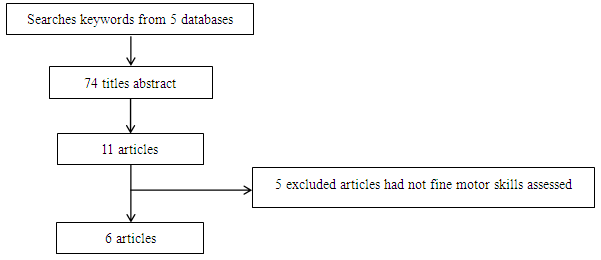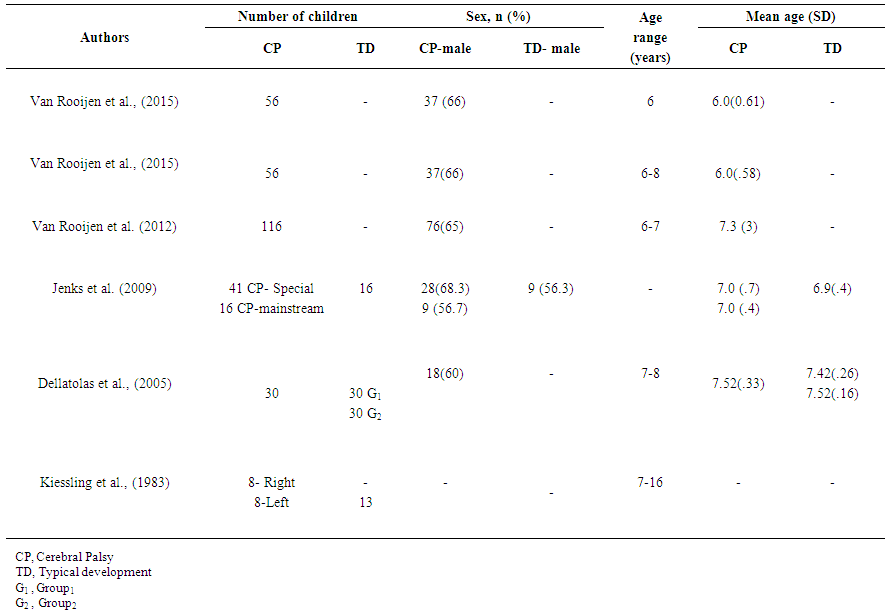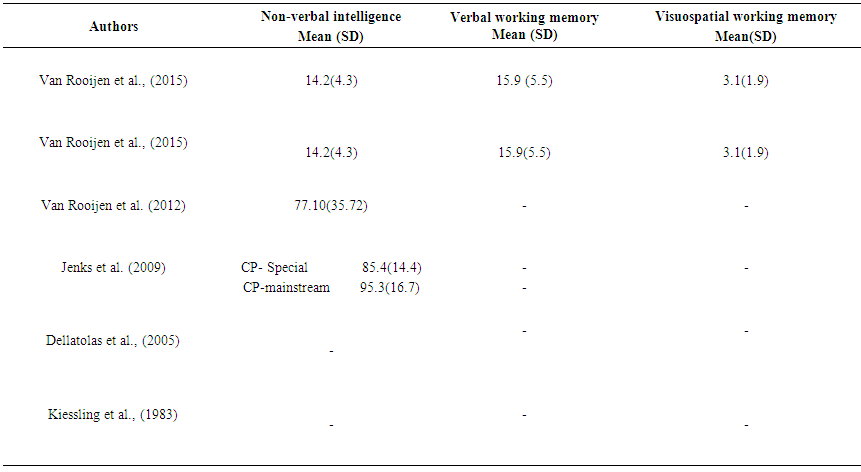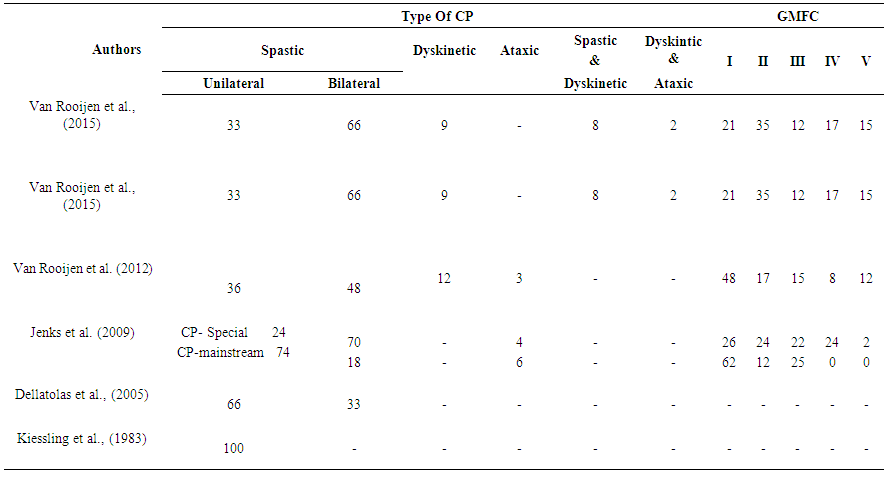-
Paper Information
- Paper Submission
-
Journal Information
- About This Journal
- Editorial Board
- Current Issue
- Archive
- Author Guidelines
- Contact Us
American Journal of Linguistics
p-ISSN: 2326-0750 e-ISSN: 2326-0769
2017; 5(2): 45-50
doi:10.5923/j.linguistics.20170502.03

The Relationship between Arithmetic Performance and Fine Motor Skills in Individuals with Cerebral Palsy
Sanaz Tajadini1, Hamid Reza Farpour2, Sima Farpour3
1General linguistics, Master of Arts (MA), Shiraz University, Shiraz, Iran
2Assistant Professor of Physical Medicine and Rehabilitation, Shiraz Geriatric Research Center, Department of Physical Medicine and Rehabilitation, Shiraz University of Medical Sciences, Shiraz, Iran
3MSc of Speech and Language Therapy, Shiraz University of Medical Sciences, Shiraz, Iran
Correspondence to: Hamid Reza Farpour, Assistant Professor of Physical Medicine and Rehabilitation, Shiraz Geriatric Research Center, Department of Physical Medicine and Rehabilitation, Shiraz University of Medical Sciences, Shiraz, Iran.
| Email: |  |
Copyright © 2017 Scientific & Academic Publishing. All Rights Reserved.
This work is licensed under the Creative Commons Attribution International License (CC BY).
http://creativecommons.org/licenses/by/4.0/

Cerebral Palsy (CP) is characterized by an atypical neurodevelopmental state which is the result of non-progressive disturbances in the developing brain. CP is accompanied by problems related to movement, posture, social interaction, language and communication. Children with CP have an increased risk of motor learning problems related to arithmetic; fine motor skills deficits are casual factors underlying arithmetic performance. The aim of this article was to provide an overview of arithmetic performance, fine motor skills and the role of fine motor skills on arithmetic. Five electronic databases (Pubmed, Scopus, Science direct, EMBASE, Central) from 1980 to 2016 were searched with keywords cerebral palsy and arithmetic performance, and fine motor skill including the word (and) between these words. Studies were included based on the following criteria: (1) participants were individuals with CP; (2) studies which assessed arithmetic performance; and (3) participants were assessed for fine motor abilities in order to evaluate the relationship between arithmetic performance and fine motor skills. Studies were excluded if participants were not CP and fine motor skills were not assessed. Search results identified 74 articles; after the review, 11 relevant articles were identified. Based on full-text, only 6 articles had the strict inclusion criteria. With regard to the high risk for arithmetic problems in individuals with CP, information about arithmetic performance and the role of fine motor skills on different components of arithmetic skills is limited. Further research should address this issue. The findings of this review are expected to have potentially important implications for educational practice and also increase our theoretical understanding of rehabilitation programs to improve manual dexterity.
Keywords: Cerebral palsy, Arithmetic, Fine motor skill
Cite this paper: Sanaz Tajadini, Hamid Reza Farpour, Sima Farpour, The Relationship between Arithmetic Performance and Fine Motor Skills in Individuals with Cerebral Palsy, American Journal of Linguistics, Vol. 5 No. 2, 2017, pp. 45-50. doi: 10.5923/j.linguistics.20170502.03.
Article Outline
1. Introduction
- Historically, the definition of Cerebral palsy (CP) has varied over the years. CP is a group of non- progressive disorders caused by brain damage in early life, often characterized in terms of its core deficits, including social interaction, language, cognition domains and musculoskeletal problems [1, 2]. These secondary impairments can progress in negative mode during their life span [3]. CP is one of the most common physical disabilities with a prevalence of 2.11 per 1000 live birth [4]. Especially, CP is classified according to the type of motor symptoms: Spastic, Dyskinetic, or Ataxic [5].As might be expected, children with CP have an increased risk of motor learning problems among all types of CP [6]. Importantly, it has been found that arithmetic learning difficulties seem to be somewhat more common in children with CP [7]. However, numerical information is known as an important aspect of our society in everyday activities such as doing educational practice, paying for shopping, and setting dates [8, 9]. Problems can occur in combination with deficits in fine motor skills.Fine motor skill is related to the use of small muscles involved in movement to manipulate objects [10]. It is associated with various aspects of physical activities such as eating, getting dressed and writing [11, 12]. For children with CP, deficit in fine motor skills may negatively impact their education especially learning arithmetic [7]. In academic achievement (learn to count and solve addition task), fingers can play a key role [13].
1.1. Arithmetic Development
- Developing of arithmetic performance is known as hierarchical manner. A literature review reported that the approximate number system can be beneficial for developing numerical presentations. Basic calculations, such as counting and comparing quantities influence the later development of intricate abilities such as multiplication and division [14]. Generally, acquisition of counting, subitizing, and simple arithmetic operations has implications in one’s daily activities, academic and work success.
1.2. Arithmetic Learning Difficulties
- Abnormal motor development in children with CP in most cases is associated with multiple disabilities [15]. As a result of these multiple disabilities these children have an increased risk of learning difficulties. However, high prevalence (44%) of learning problems can be interpreted in these [16, 17]. Liptak and Accardo [18] reported that it is estimated that 75% of the children with CP are slow learners. Based on a few available studies, learning difficulties in the area of arithmetic is more observed in children with CP. For example, among children with CP who follow mainstream education, 78% were found to have mild difficulties in arithmetic performance [19]. One study showed that 36% of these children had specific learning difficulties, with 25% having difficulty in arithmetic [7]. There are many factors that can impact the arithmetic performance, for example, cognitive items such as working memory, executive function, and non-verbal intelligence [20, 21]. Furthermore, Cameron and colleagues [22]; Bender and Beller [13]; and Wood & Fischer [23] concluded that fine motor skills can be one of the most important factors which can limit the level of arithmetic performance. It is obvious that children with CP have manual dexterity deficits which may negatively affect their arithmetic performance. The aim of this study is to provide an overview on arithmetic performance, fine motor skills and the role of fine motor skills in arithmetic performance in children with CP.
2. Methods
2.1. Search Strategy
- Five electronic databases (Pubmed, Scopus, Science direct, EMBASE, and Central) from 1980 to 2016 were searched with keywords "cerebral palsy" and "arithmetic performance", and "fine motor skill".
2.2. Inclusion / Exclusion Criteria
- Studies were included based on the following criteria: (1) the participants were individuals with CP; (2) studies assessed arithmetic performance; (3) participants were assessed for fine motor abilities in order to evaluate the relationship between arithmetic performance and fine motor skills. Studies were excluded if participants were not CP, and fine motor skills were not assessed.
2.3. Data Extraction and Analysis
- Data extraction was performed on all articles according to inclusion criteria as (1) the participants’ characteristics, (2) measurement of arithmetic performance and fine motor skills, and (3) level of arithmetic performance and motor function.
3. Results
- Our search results identified 74 articles (Fig. 1). After review, 11 relevant articles were identified. Based on full- text, only 6 articles had the strict inclusion criteria [24-29], among which two articles [24, 25] were found in the reference lists.
 | Figure 1. Flow chart of searching result of the relationship between arithmetic performance and fine motor skills in children with cerebral palsy |
3.1. Participants’ Characteristic
- Participants’ characteristics are shown in Table 1. Two of the included studies recruited 56 children with CP and motor disabilities and examined whether fine motor skills are significantly related to the arithmetic performance of children with CP [28, 29]. A study with 116 primary school children based on a formal diagnosis of cerebral palsy explored the influence of motor variables on arithmetic performance [27]. Another study compared arithmetic performance based on the children’s motor skills in 41 children with CP in special education, 16 children with CP in mainstream education, and 16 typically developing children as the control group [26]. The two last studies investigated the effect of manual skills and hand skill asymmetry during counting performance in children with CP and control group and reported performances of children with right and left hemiplegia and sibling controls on a test of manual dexterity and arithmetical computation skill, respectively [25, 24]. The mean, standard deviation and percentage of included factors can be found in Table 1, 2 and 3.
 | Table 1. Summary of participates’ characteristics |
 | Table 2. Descriptive statistics of the included variables |
 | Table 3. Type of CP and Gross motor Impairment in percentage |
3.2. Measurement of Arithmetic Performance and Fine Motor Skills
- Several different measures were used to assess the arithmetic performance and fine motor skills. Two studies used The Early Numeracy Test- Revised to assess arithmetic and numeracy performance of children with CP [28, 29]. This comprehensive task consists of two parts which emphasizes the concepts of comparison, classification, one-to-one correspondence, counting skills and general understanding of numbers as well as addition and subtraction items. Fine motor skills of these children were assessed by the Box & Block test which is divided by a partition into two equal sides. The children had to move the blocks with both hands separately to the other side of the box as quickly as possible in one minute. In a study, the measurement of motor ability was done through Abilhand questionnaire which examines children’s manual dexterity in daily activities. It is a parent reported about «what a child usually does» to indicate whether his/her child performs this action in an easy, impossible or difficult way. Arithmetic performance was measured with a standardized arithmetic achievement test, the Student Monitoring System for Arithmetic Performance. This test includes three parts for addition, subtraction and multiplication problems [27]. In another study, an addition, a subtraction test and the Bimanual Fine motor Function Scale were administered to measure the children’s arithmetic ability and fine motor impairment of children with CP, respectively [26]. Another paper measured manual skill with the Computerized Peg Moving task (moving the pegs to the hole as quickly as possible) and among 19 subtests of the Neuropsychological battery, two involved counting (counting dots and Counting backwards) could be considered as an assessment of mathematical performance [25]. In the last study, the degrees of hand impairment and arithmetic problem-solving were assessed with the Annett Pegboard and the Wide Range Achievement Test [24].
3.3. Relationship between Arithmetic Performance and Fine Motor Skills
- Six studies reported a relationship between arithmetic performance and fine motor skills in children with CP [24-29]. Two studies that examined an association between arithmetic and numeracy performance of children with CP and their fine motor skills found a positive relationship between fine motor skills and arithmetic performance [28, 29]. Another study using the Student Monitoring System for Arithmetic Performance and the Abilhand questionnaire investigated the influence of motor variables on arithmetic performance. This study reported that fine motor skills were related to the ability to solve addition and subtraction tasks in primary school children with CP [27].The study that used an addition, a subtraction test and the Bimanual Fine motor Function Scale in 41 children with CP in special education, 16 children with CP in mainstream education, and 16 typically developing children highlighted the importance of left-hand impairment for arithmetic computation skills in children with CP, and showed that the slower the speed to solve addition and subtraction tasks, the greater the hand impairment of children with CP [26]. Furthermore, there were two studies reporting a strong correlation among poor mathematical computation, counting performance, and left-hand impairment [25, 24].All studies that compared arithmetic performance between children with CP and their typically developing peers reported that children with CP performed less arithmetic performance than typically developing peers [26, 25, 24].
4. Discussion
- Based on our search, there are not many studies published on this topic. This review aimed to improve our understanding of arithmetic performance in children with CP to scrutinize the possible role of fine motor skills in arithmetic skills. This study also reviewed different measurements of the included studies. With respect to different measurements, and also included variables of these studies such as; gender, age, type of CP, Gross motor Impairment, non verbal intelligence, verbal working memory, and visuospatial working memory, this enabled us to better clarify the validity of the results in an objective manner.It has been stated that this review study has some limitations due to the variety of studies. First, some of the included articles had not used validated versions of the existing tests for children with CP and there was a lack of validated tasks to assess performances of children with CP. Second, experimental design of some articles was not completely described. Furthermore, these articles used different measurement to assess arithmetical skills and fine motor skills which can have bias and errors. Altogether, these limitations impede the interpretation and generalization of the results.Using validated and standardized norm referenced tests or comprehensive experimental design to assess arithmetic and numeracy performance and fine motor skills are recommended for future research.Although there is abundance great number of studies on arithmetical skills of children with CP, specific information regarding the relationship between arithmetic performance and fine motor skill and also its role in different components of mathematical skills is lacking. Therefore, further research should focus on this issue in children with CP using valid and reliable measures. The direction of this influence is a matter of debate. More knowledge about the relationship between arithmetic learning problems and fine motor skills may have implications for the development of evidence-based intervention programs and learning protocols for children with CP.
5. Conclusions
- The substantial aim of this review was to provide a starting point with respect to arithmetic learning problems in children with CP and to examine the role of fine motor skills in these problems. There are few studies in this domain. An overall significant effect of fine motor skills has been reported with regard to the ability to solve addition and subtraction tasks in this group of children. With respect to different measurements, we found that the relationship between fine motor skills and arithmetic performance was positive (the slower speed to solve mathematical computation was associated with greater hand impairment). The precise nature of this relationship remains to be further investigated. In addition, the remedial education and training of fine motor skills might accelerate their arithmetical abilities. So, insight in motor learning, and arithmetic learning problems in relation to fine motor skills will advance the development of evidence -based intervention programs in children.
ACKNOWLEDGMENTS
- The authors would like to thank the Research Consultation Center (RCC) of Shiraz University of Medical Sciences for their invaluable assistance in editing the manuscript.
 Abstract
Abstract Reference
Reference Full-Text PDF
Full-Text PDF Full-text HTML
Full-text HTML